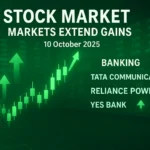Journey to Sensex 100000
Every morning, retail investors open apps and watch tiny green and red bars flicker across their screens. They chase intraday moves, read headlines, and refresh portfolio values. Farmers start their day differently: with a hand on the soil, a glance at the sky, and a long memory of seasons. They know success isn’t about watching prices every hour — it’s about understanding the land, the weather, and planting in the right season.
If you’re aiming at Sensex 100000, you need that farmer’s patience and perspective. The goal isn’t to guess every market twitch; it’s to identify the parts of the economy with the right soil, sunlight and staying power — the sectors that will reliably yield harvests for years. Some fields will be perennials; others will be one-season wonders. To decide where to plant capital for the long run, start by inspecting how India’s market is currently tilled.
Sensex Architecture: A Market Built on Heavyweights
The Sensex is a market-cap-weighted index of 30 stocks — it’s not designed for rapid turnover. Instead it reflects where the largest companies and the biggest pockets of capital sit. Today, that foundation is surprisingly narrow.
| Sector | Approx. Weightage | Key Sensex Companies |
|---|---|---|
| Financial Services (Banks & NBFCs) | 31.00% | HDFC Bank, ICICI Bank, Bajaj Finance |
| Information Technology (IT) | 13.60% | TCS, Infosys, HCL Tech |
| Petroleum Products / Energy | 11.50% | Reliance Industries Ltd. |
| Automobile | 7.40% | Maruti Suzuki, M&M, Tata Motors |
| FMCG / Consumer goods | 6.80% | HUL, ITC |
Top 5 concentration = 70.30%
Put bluntly: banks and lenders alone account for roughly a third of the index, and with tech, energy, autos and FMCG, the top five sectors represent more than 70% of the Sensex. That dominance explains why the index has climbed when a few heavyweights perform well — and why it can wobble if any of them falter.
There are two realistic paths for Sensex to reach 100,000:
- Direct path: earnings expansion and valuation growth inside the existing heavyweights; or
- Indirect path: newer sectors rise, increasing activity, investment and efficiency in the economy — the benefits then flow through to the thirty companies in the Sensex.
Both routes are plausible. The question for investors is: which sectors will supply the sustained growth — the “right soil” — for the next decade?
A Quick History: Not All Bull Markets Are Built the Same
Bull runs don’t happen in a vacuum. The 1990s rally rode liberalisation; a later leg to 50,000 was fuelled by booming tech exports, easy credit, and an energy tailwind. Each cycle has its unique foundation.
Today’s environment looks different. Several of the old engines have reached natural limits. Information technology, for example, built India’s export story by delivering high-quality talent at lower costs. But that model faces headwinds: rising protectionism, tighter visa regimes and higher wage expectations are reshaping the economics.
Two concrete policy shifts underline this change:
- A recent hike of roughly US$ 100,000 in H-1B visa processing fees, and
- The proposed 25% outsourcing tax in the U.S.
These moves favor specialized, higher-wage applicants and local hiring — eroding some of the margin benefits that once flowed to Indian IT exporters. Automation and domestic competitors abroad are tightening margins further. IT firms will remain profitable and relevant, but their era as the fastest-growing Sensex engine is nearing a turning point.
That’s why the next wave must be domestically fuelled, demand-linked, and structurally deep — built on sectors where policy, technology and everyday life intersect.
The Financial Engine: Credit, Technology and Trust
If the economy is a living organism, finance is its circulatory system. The transformation underway in financial services is not incremental — it’s structural.
India’s Digital Public Infrastructure (DPI) — Aadhaar, Jan Dhan, and UPI — created shared digital rails that brought millions into the formal economy and enabled rapid FinTech innovation without rebuilding the core plumbing from scratch.
Key data points:
- Industry estimates place the DPI-powered ecosystem’s potential income at US$180–200 billion by 2030.
- Banks saw momentum dip — FY26 loan growth slowed to around 2% and margins tightened — but a recovery is visible. Consensus on Dalal Street expects nearly 18% annual profit growth in FY26–FY28.
- NBFCs are set to grow fast: assets under management (AUM) could double to ~₹100 trillion by 2030.
Why this matters: financial services will likely remain the largest engine in the index — not just because of credit cycles, but because digital credit, policy, and consumer trust compound each other. Banks, NBFCs and fintech players together create a resilient growth basal layer for the Sensex.
Infrastructure & Capital Goods: The Economic Multiplier
Infrastructure spending builds permanent capacity. India’s focus here is concrete and ambitious.
The PM GatiShakti National Master Plan has coordinated nearly 300 projects worth about ₹13.6 trillion (~US$155 billion). Importantly, public investment doesn’t just add roads and rails — it multiplies economic activity. RBI and NIPFP research suggests public investment can boost national income by ₹2.5–3 for every ₹1 spent.
This multiplier feeds capital goods, construction equipment, cement, steel, and logistics demand — raising capacity utilisation and corporate profits over time. In short: infrastructure spending seeds multiple corporate winners — the sort that can push earnings growth on a broad base required to reach Sensex 100000.
Manufacturing: The New Industrial Backbone
Manufacturing used to be an aspiration; now it’s a strategic priority.
The Production-Linked Incentive (PLI) scheme is central to that shift — it rewards actual output and investment, not promises. The PLI has already delivered measurable results: 74 textile companies have committed nearly Rs.28,711 crore in investments under PLI alone. Electronics, auto components and other segments are seeing increasing domestic value-addition.
Other signals:
- India is among the top ten nations in robot density, and automation is rising steadily.
- But challenges remain: some early PLI beneficiaries are nearing the end of incentive periods, and export growth is flattening in areas where the tapers begin.
The solution is clear: PLI must evolve up the value chain — toward R&D, EV battery manufacturing, green hydrogen, and precision engineering. If it does, manufacturing can become a durable source of high-quality jobs, exports, and corporate profit — all essential to the Journey to Sensex 100000.
Energy Transition: Powering the Future
The energy story is both strategic and economic. Over the last decade India’s renewable capacity surged from ~76 GW to nearly 234 GW, placing the country 4th in the world. Growth rates are projected between 18–25% annually as solar, wind and nascent green hydrogen scale up.
The Green Hydrogen Mission aims to reduce fossil-fuel imports and clean heavy industries like steel and refining. This will require sustained investment in generation, transmission and storage — and create a long runway for companies building the grid and generation capacity (think NTPC, Power Grid and leading private renewable developers).
Energy transition is not a peripheral ESG narrative — it is a strategic industrial policy with deep economic consequences. The companies that build those rails will be the backbone of future growth.
Discretionary Consumption: The Demand Dividend
Policy can nudge demand. A proposed GST 2.0 reform intends to simplify the current four-rate structure into two main slabs (5% and 18%), excluding sin goods. If implemented, analysts estimate this could lower retail prices by ~4–5% for many high-value products currently taxed at the 28% slab.
The direct winners are obvious: Maruti, Tata Motors, Hindustan Unilever, ITC and Voltas among them. But the broader effect is profound: price relief combined with improving household liquidity and rising incomes can trigger a sustained, consumption-led expansion, supporting jobs, corporate profits and stock market breadth.
Putting the Pieces Together: The Long Game to 100,000
Reaching Sensex 100000 will not be a single flash; it will be the arithmetic of compounding across multiple sectors:
- Finance expands as DPI deepens financial access and credit products.
- Infrastructure multiplies demand across the economy.
- Manufacturing raises domestic value-add and supply chains.
- Energy transition secures supply and builds new industries.
- Discretionary consumption translates income into sustained corporate revenue growth.
Markets will always have noise — global cycles, commodity price shocks, policy surprises. But the most reliable way to the milestone is steady, structural progress across these five pillars. Companies that keep building capacity, investing in productivity, and navigating regulatory changes quietly compound value.
The number 100,000 is not destiny by magic; it’s a scoreboard. It will arrive when millions of small, consistent changes in the economy add up — when public investment works like a multiplier, manufacturing scales, households spend more, and technology improves productivity.
Risks to Watch (so you don’t plant in bad soil)
No plan is complete without identifying what could go wrong:
- Global recession or commodity shocks — these can squeeze margins and slow growth.
- Policy implementation lags or tax surprises — delays or poorly designed reforms could sap momentum.
- Valuation overheating and speculative retail froth — sharp corrections can occur even in bullish markets.
- Geopolitical disruptions — supply chains, oil prices, or trade can be affected suddenly.
But India’s domestic liquidity, expanding investor base, and diversified engines provide resilience. The trick for investors: be aware, not fearful; allocate, not speculate.
How to Think Like a Farmer — Investment Rules for the Journey
- Assess the soil: Favor sectors with structural tailwinds (finance, infra, manufacturing, energy, consumption).
- Plant in seasons: Time exposures across cycles — add on dips, modestly on rallies.
- Diversify across fields: Use sector ETFs, quality large caps, and selective mid-cap exposures to balance growth and stability.
- Measure yield, not noise: Track earnings growth, margins and capex, not intraday price moves.
- Be patient: The journey to Sensex 100000 is long-term. Compounding requires time and discipline.
Final Harvest: What 100,000 Really Means
The Journey to Sensex 100000 is not an obsession with a number — it’s a map of India’s economic priorities. It means better infrastructure, deeper manufacturing capabilities, cleaner energy, wider financial inclusion and more robust consumer demand. It means millions of investors moving from savings to ownership, and a modern economy translating policy into productivity.
So start each financial morning like a farmer: check the conditions, understand the sectoral soil, and plant where the fundamentals are fertile. If you invest in the right sectors and give them time, the harvest — measured in sustained corporate profits and a rising Sensex — will follow.
Related Articles
Read Our All Newsletter On Pre-Market Analysis
One Demat, Multiple Benefits: Power of a Single Demat Account





